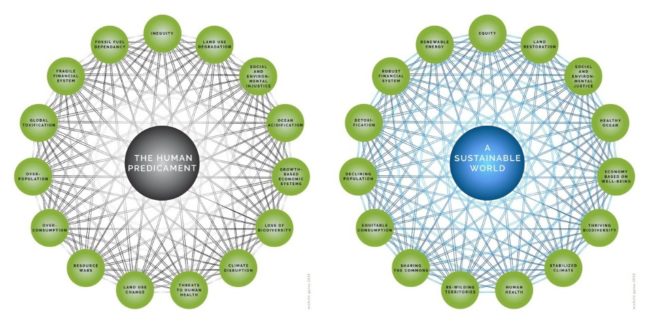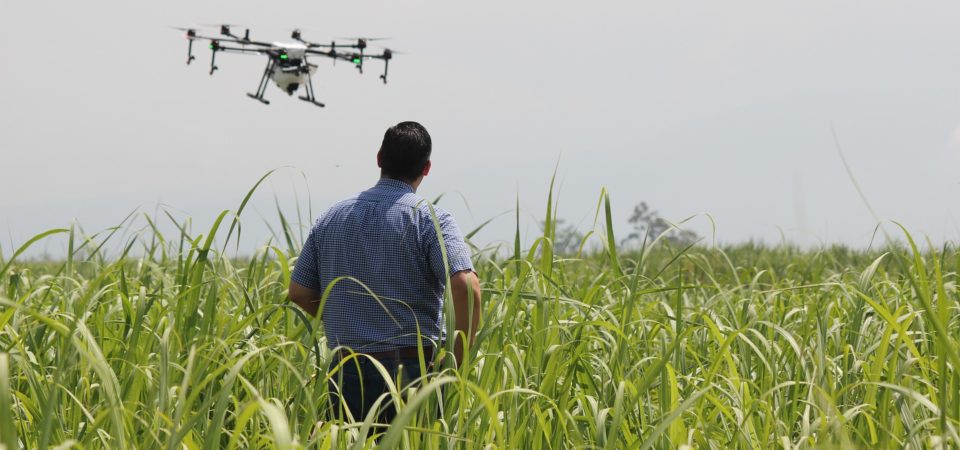The MAHB challenge is to transform “The Human Predicament” and the consequences of the Anthropocene Era into a “Sustainable World” – a new Manus Era. This is usually referred to as a “wicked problem”. I know civil society can solve this.
Progress toward this balanced biosphere takes four steps as shown below. Then it will be discussed for its impact on food production.
1. Words matter: the meme
The Anthropocene Era, involving human activity, has consequences, for example, a projected 2°C temperature rise so far. It has to be replaced by a “Manus Era”, that is, human activity with intelligence and personalized for the planet. This is a better word for me, and I think also for the planet since it attaches responsibility for human activity to us and involves judgments about actions as being good or bad for the biosphere.
Then there is the personal and collective responsibility. I personalize this issue as “Manus”, a combination of Manaus, the “heart” of the Amazon, and for mankind, including you and me, personalized, for the projected 10bn people. When in 1979 I sat in Manaus the enormity and role of the Amazon were tangible and unforgettable. Also in 1979, at the Climate Conference in Geneva, the World Meteorological Organization recognized the role of carbon dioxide in the atmosphere with its implications for mankind. Today the Amazon emits more carbon dioxide than it absorbs. Is this the day its heart stopped?
2. Actions count but management is needed
Actions speak louder than words. In the Anthropocene, the consequences of actions by humans can be seen and felt, too late, but important for feedback and learning. The IPPC’s Sixth Assessment Report on the climate established the current status, cause, and consequences of actions. The current 1.1°C temperature rise is already creating havoc; an unstoppable, projected 2°C rise will ravage many biological entities and a rise of 4°C would be unmanageable for life and potentially obliterate all but microscopic entities. In the Manus Era, the management of human activity must occur in advance to ensure only the minimum of unintended consequences for a balanced biosphere.
3. Turn ideas into actions – with proof
In the Manus Era, success means having a balanced biosphere. This transformation requires specific actions across multiple entities with professional management and linked to personal behavior. The knowledge, aptitude and energy/resources are available and will continue to be developed. New “vehicles” are needed for the actions, such as education, technologies, a system, an institution, software, etc. However, they must meet the stringent time, biosphere, social and economic constraints needed for a balanced biosphere. Proof is required that actions will have a positive impact before they are implemented.
4. Mobilize all people, especially scientists
Globally scientists are available and are working on many positive actions. Many more have to be rapidly mobilized to speed up the process, especially as we have the IPPC’s proof of significant global heating since the 1980s and with the real potential to run out of control.
A system of proof is needed so that all proposed actions and vehicles achieve success: a balanced biosphere and a sustainable world. We propose a system to register, record, reward, and pay scientists when there is proof. Intellectual property is a historical approach but many actions can’t be categorized like this and that stifles creativity.
The ability to establish proof and reward, then track and reward, will create incentives to solve global problems. Further, the same system can be used to recognize and reward any citizen for “good behavior”. Methods have been developed to reward and/or pay any person or entity that undertakes proven climate or biosphere improvement actions.
5. From agriculture to agrinurture
Words matter. Agriculture is “the science or practice of farming” whereas nurturing is “the act of encouraging, nourishing, and caring for someone or something”. Agrinurture, therefore, is the act of encouraging, nourishing, and caring for both a part and the whole of the biosphere.

A farmer acknowledges responsibility and accountability for the management of their physical part of the planet, however small, and the consequences for the whole planet. The biosphere has to be continuously measured and managed to enhance biodiversity, retain species, productivity, and reduce gases, carbon dioxide in particular.
Agribusiness is the world’s largest industry and the only industry that can sequester greenhouse gases at scale. This happens mostly by using natural processes so agribusiness is critical for a balanced biosphere and ensuring nutritious food for all. There’s more carbon in the top meter of soil than in the Earth’s air and plants combined.
To the farmer, Agrinuture is “the application of knowledge and embedded knowledge to the individual nurturing of plants and animals for a balanced biosphere”. The precise treatment of each plant and animal requires an understanding of their ecological synergy, nutritional requirements, reaction to intruders, climatic impacts, and the nutritive value of the output.
Agribusiness is a collaborator with agrinurture in pursuing a balanced biosphere. It supports the farmer in numerous ways, from providing inputs of seed and fertilizer, to procuring and if required processing the product.
Research and development provide the means to identify and measure the parameters needed to define these and other components, allowing them to be modeled, having their futures forecast, decisions made, and if required, treatments applied.
Each square meter of space needs measurement, modeling, and a visualization description in 3D to reflect the reality of the plants and animals in the biosphere. The automated collection of this mass of data must be delivered to the land manager in a manageable form, anywhere, anytime, and transferable to autonomous machines.
Knowledge will continue to define any treatments required to ensure agriculture, healthy landscapes, healthy soils, healthy plants, healthy animals, healthy people, and a balanced biosphere. Decisions by land managers are to be based on “proofs”.
Continuous monitoring of the landscape with satellite, drone, or ground autonomous vehicles provides a time series of the state of the space and determination of rates of change in the landscape. These can be in high resolution and captured in 3D. With the appropriate technology, they can be viewed on large screens or modified for handheld devices in real-time, anywhere. The transfer of transformed data can instruct human or automated treatments including the delivery of chemicals in solid or liquid forms, seeds, or plants by autonomous land or aerial devices. These devices can also have edge computing to discriminate between plant types, states, health, or status to variably apply the treatment, on the run.
All actions, especially “treatments” can modify the biosphere and accumulate or destroy natural capital – locally or globally. For example, in the immediate term treatments can destroy microbes and local spray drifts can destroy neighbors’ crops. Globally, negative effects on the biosphere include impacts on the water, nitrogen, phosphorus, or carbon cycles. However, proper management by farmers, now increasingly happening, treatments can be both efficient and very positive. It is especially critical to manage water, carbon dioxide, methane, and nitrous oxide in the Agrinurture system. This applies to both above and below ground and especially to treatments with nitrogen and phosphorus. The result is a balanced biosphere.
 Dr. John Troughton has a background in biophysics especially concerning the carbon cycle from plants to farms to forests. He first measured CO2 in the atmosphere in 1965 and has followed it ever since. John became interested in energy at Stanford University in 1974 during the energy crisis and this led to his current interest in renewable energy, solar, and batteries. The current climate crisis generated his current project, leading global efforts to search for and prove any action that benefits the biosphere and its climate. This also links to his interests in precision agriculture and the use of autonomous vehicles for precision land management. He can be reached at John.h.troughton@gmail.com.
Dr. John Troughton has a background in biophysics especially concerning the carbon cycle from plants to farms to forests. He first measured CO2 in the atmosphere in 1965 and has followed it ever since. John became interested in energy at Stanford University in 1974 during the energy crisis and this led to his current interest in renewable energy, solar, and batteries. The current climate crisis generated his current project, leading global efforts to search for and prove any action that benefits the biosphere and its climate. This also links to his interests in precision agriculture and the use of autonomous vehicles for precision land management. He can be reached at John.h.troughton@gmail.com.
The MAHB Blog is a venture of the Millennium Alliance for Humanity and the Biosphere. Questions should be directed to joan@mahbonline.org

